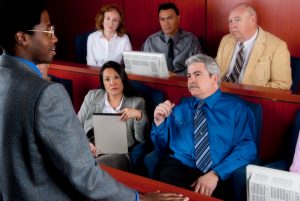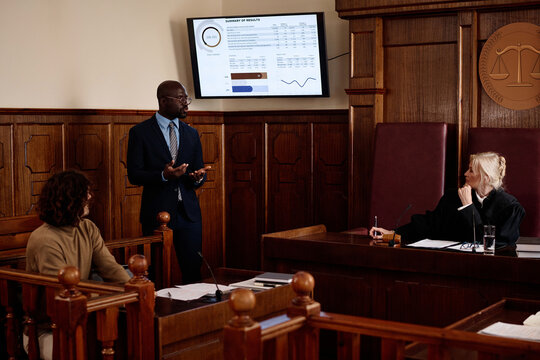Understanding the Art of Trial Presentations: Secret Strategies for Efficient Lawful Arguments
Browsing the Complexities of Test Presentations: Tips for Seamless Shipment and Engaging Disagreements
In the realm of legal procedures, the art of test discussion stands as an essential determinant of success. The complexities inherent in trial presentations require a delicate balance of skill, ability, and approach.

Understanding Trial Goals
To successfully browse a test, it is essential to have a clear understanding of the goals that need to be accomplished. Prior to tipping right into the courtroom, legal teams should define their goals and desired outcomes. These goals function as assisting concepts throughout the test, forming methods and affecting decision-making procedures.
Recognizing test goals includes a detailed evaluation of the situation, lawful precedents, and the client's benefits. Trial Presentations. It needs a precise evaluation of the truths, identifying essential issues, and anticipating potential obstacles. By establishing certain and measurable goals, lawyers can customize their disagreements and presentations to straighten with the preferred results
Moreover, a clear grasp of test objectives makes it possible for legal teams to prioritize evidence, witnesses, and lawful debates successfully. It enables the development of a systematic narrative that resonates with the discretionary, strengthening the total situation presentation.

Organizing Proof Properly
Having a clear understanding of test objectives lays the structure for organizing evidence properly in lawful procedures. By straightening the presentation of proof with the preferred end results of the trial, legal groups can enhance their debates and improve their persuasiveness.
An additional crucial element in arranging evidence successfully is establishing a rational circulation. Providing proof in a consecutive and coherent way can help build an engaging narrative that supports the lawful arguments being made. Furthermore, making use of visual aids such as charts, graphes, or timelines can further improve the company of proof and assist in clearing up intricate relationships or sequences of events.
Additionally, making certain that all proof presented is appropriate and acceptable to the instance is necessary. Inadmissible or pointless proof can interfere with the stamina of the argument and potentially hurt the reputation of today party. Therefore, a meticulous evaluation and selection process ought to be taken on to include just the most lawfully sound and impactful proof in the trial presentation.
Crafting Persuasive Stories
Crafting engaging narratives plays an essential role in offering convincing arguments during lawful procedures. When constructing a narrative for a test presentation, it is essential to develop a clear storyline that highlights vital points and attaches them in a coherent fashion. By weaving together proof, testimony, and legal debates into a natural and persuasive narrative, lawful specialists can successfully support for their clients and boost the likelihood of a positive end result in see this website the courtroom.
Understanding Visual Aids
Efficient usage of visual aids is crucial to boosting the effect and clarity of trial presentations. Aesthetic help, when utilized tactically, have the power to streamline intricate information, reinforce essential factors, and leave a lasting impression on the discretionary. To grasp aesthetic help in trial presentations, it is important to make sure that they are clear, succinct, and pertinent to the arguments being made.
When incorporating visual aids, such as charts, charts, photos, or timelines, right into a test discussion, it is important to maintain them visually appealing yet expert. The visuals must match the verbal disagreements, giving a visual depiction of the details being reviewed without frustrating the target market with unneeded details.
Furthermore, experimenting the visual aids ahead of time is vital to guarantee a seamless delivery throughout the test. Acquainting oneself with the material, shifts, and timings of each visual help can aid preserve the flow of the presentation and protect against technological problems that may arise.
Supplying Impactful Closing Debates
A compelling closing argument works as the end result of a trial presentation, enveloping the core story and persuading the court and court towards a favorable choice. To deliver an impactful closing debate, it is critical to succinctly evaluate essential factors, highlight the staminas of your case, and resolve any type of weaknesses in a critical way. Begin Read Full Report by outlining the primary arguments that sustain your client's placement, highlighting why the proof provided throughout the test supports your narrative. It is vital to create a feeling of cohesion and quality, assisting the discretionary in the direction of the desired verdict.
In addition, integrating emotional charm can better reinforce your closing read review debate. By connecting and humanizing the situation on an individual level with the decision-makers, you can stimulate empathy and understanding, influencing their assumption of the facts presented. Furthermore, stating the legal requirements that need to be fulfilled for a favorable ruling can strengthen the legitimacy of your placement. Ultimately, a well-crafted closing argument ought to leave an enduring impact, engaging the discretionary to rule in your client's favor.
Conclusion
In conclusion, mastering test discussions entails recognizing purposes, arranging proof, crafting narratives, utilizing visual aids, and supplying impactful closing debates. By applying these approaches properly, legal representatives can provide their situation perfectly and make compelling debates in the court room. It is vital to browse the complexities of trial discussions with accuracy and skill to achieve success in lawful procedures.
By lining up the presentation of proof with the preferred outcomes of the test, lawful teams can reinforce their debates and boost their persuasiveness (Trial Presentations). To grasp visual help in trial discussions, it is critical to make sure that they are clear, concise, and pertinent to the disagreements being made
A compelling closing debate serves as the culmination of a test presentation, enveloping the core narrative and encouraging the judge and court towards a favorable choice. Begin by describing the major disagreements that sustain your client's placement, highlighting why the evidence provided throughout the trial sustains your story.In final thought, understanding trial discussions includes recognizing goals, arranging evidence, crafting stories, utilizing aesthetic help, and providing impactful closing debates.